From monarchs to swallowtails to delicate fritillaries, there are so many butterflies to enjoy! But if you adore these winged beauties, why not try to attract them to your garden by planting flowers just for butterflies?
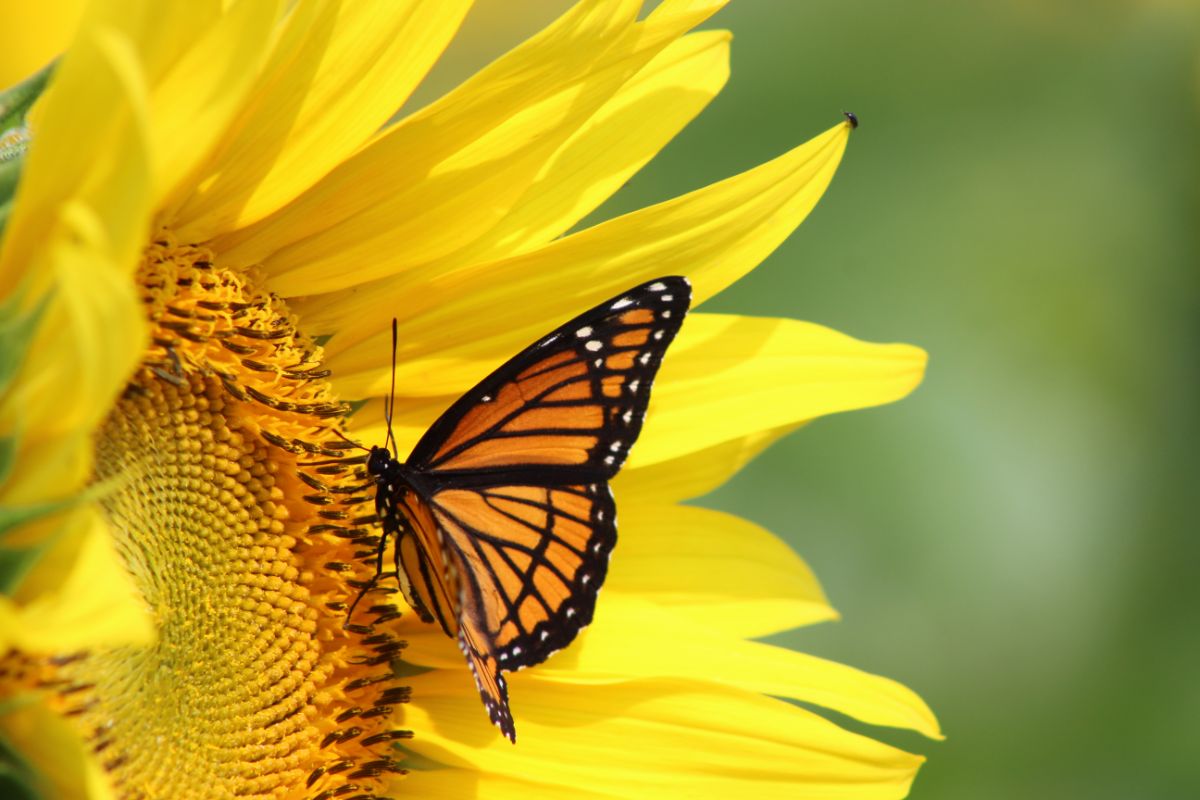
Many native plants, as well as popular ornamentals and herbs, are highly attractive to butterflies. Sowing these flowers in your garden can bring butterflies to your space. Once they arrive, kick back in your favorite lawn chair (or hammock!) and watch the stunning colors and bewitching flight patterns of these top pollinators enjoying your newly planted blooms.
Jump to:
- 20 best flowers to grow for butterflies
- 1. Milkweed (Asclepias spp.)
- 2. Butterfly bush (Buddleja spp.)
- 3. Butterfly weed (Asclepias tuberosa)
- 4. Sunflower (Helianthus spp.)
- 5. Tall phlox (Phlox paniculata)
- 6. Purple coneflower (Echinacea purpurea)
- 7. Lantana (Lantana camara)
- 8. Black-eyed Susan (Rudbeckia hirta)
- 9. Joe Pye weed (Eutrochium purpureum)
- 10. Hollyhock (Alcea rosea)
- 11. Verbena (Verbena spp.)
- 12. Goldenrod (Solidago spp.)
- 13. Dill (Anethum graveolens)
- 14. Sedum (Sedum spp.)
- 15. Salvia (Salvia spp.)
- 16. Liatris (Liatris spicata)
- 17. Anise hyssop (Agastache foeniculum)
- 18. Lavender (Lavandula spp.)
- 19. Zinnia (Zinnia elegans)
- 20. Yarrow (Achillea millefolium)
- Summary
20 best flowers to grow for butterflies
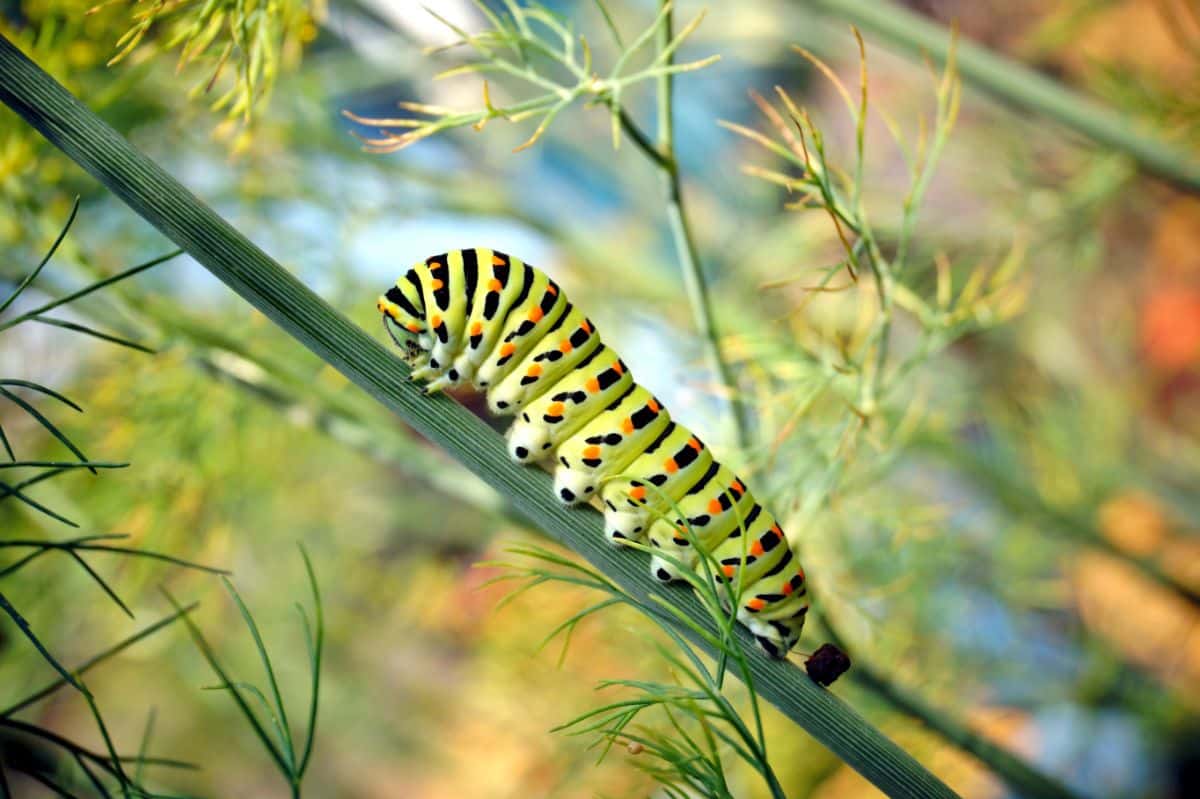
The flowers below are some of the top plants to try if you want to draw butterflies to your landscape. For best results, try planting a number of different species, as some plants are more attractive to butterflies at different stages of their lifecycles. And, of course, whenever possible, opt for organic gardening methods to keep your butterfly visitors healthy and thriving.
1. Milkweed (Asclepias spp.)
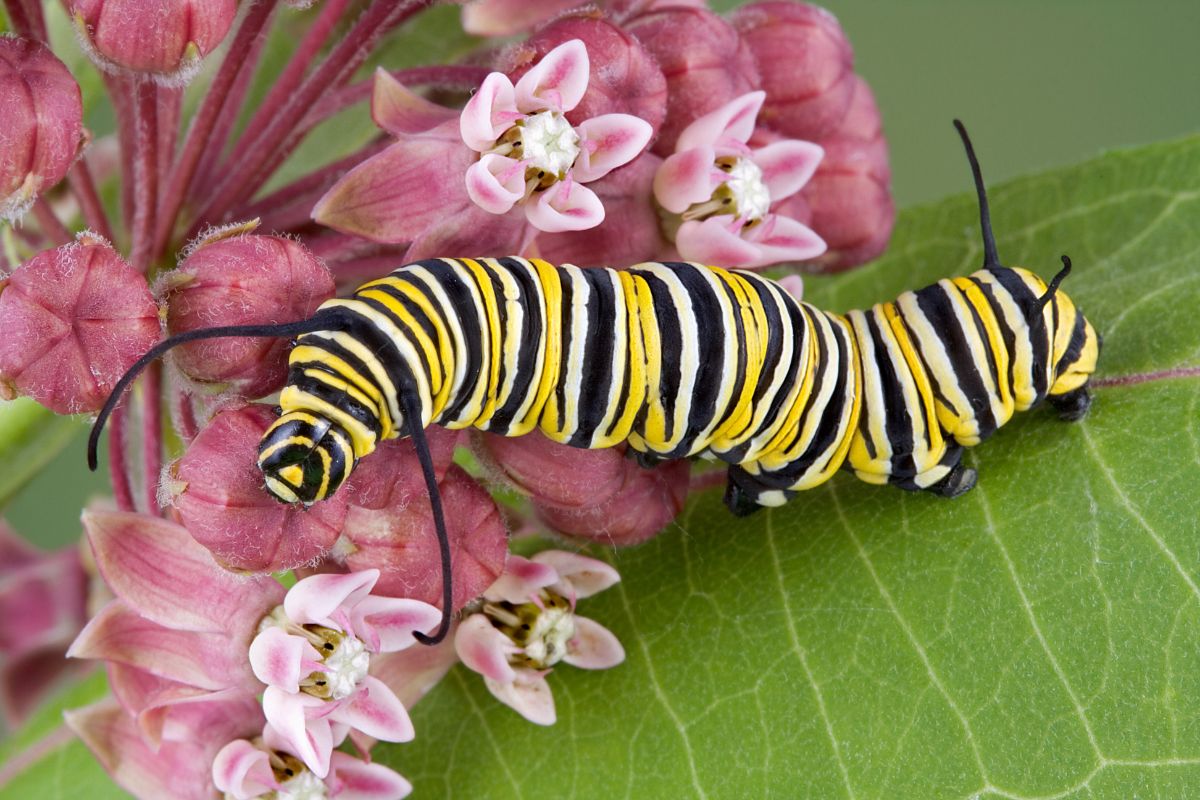
| Plant name: | Milkweed |
| Light requirements: | Full sun |
| Water requirements: | Low |
| Perennial or annual? | Perennial |
| Growing zone: | Zones 4 to 9 |
Milkweed is famous for being one of the top plants to grow if you want to attract butterflies. This is because these plants are critical for the development of monarch butterflies.
Monarch butterflies only lay their eggs on milkweed species, and these plants are the only food source for developing monarch caterpillars. With monarch populations on the decline, one of the best things you can do is make sure you plant plenty of milkweed in your garden!
2. Butterfly bush (Buddleja spp.)
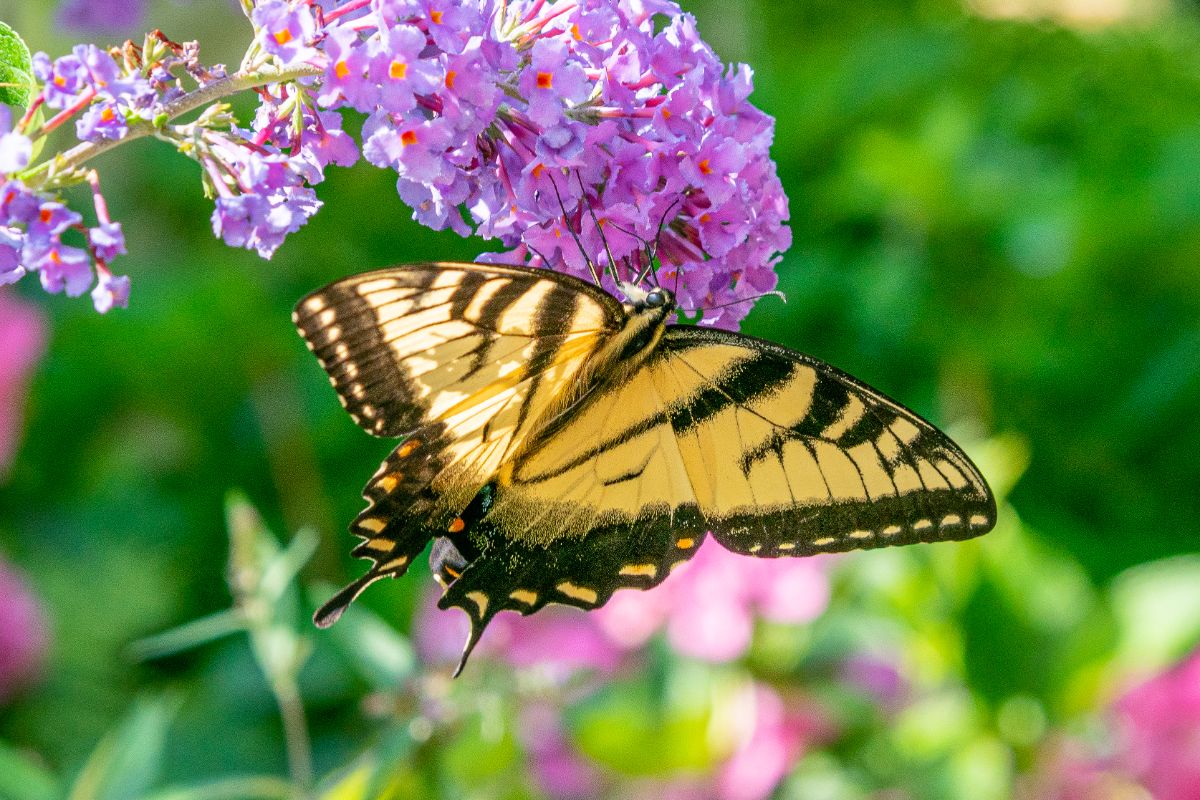
| Plant name: | Butterfly bush |
| Light requirements: | Full sun to part shade |
| Water requirements: | Moderate |
| Perennial or annual? | Perennial |
| Growing zone: | Zones 5 to 9 |
It’s no surprise that butterfly bushes are the top choices for butterfly habitats. These fast-growing shrubs stretch up to 15’ tall and produce a wealth of fragrant flowers that come in white, purple, pink, and blue. Once in bloom, flowers are irresistible to butterflies, as well as other garden visitors like hummingbirds.
Butterfly bushes are easy to care for, and they will come back year after year, although they frequently sustain some damage during the winter months. That’s why it’s a good idea to prune these plants in spring after the first buds emerge. Make your pruning cuts just above where the new buds appear to remove old, spent, and woody growth.
3. Butterfly weed (Asclepias tuberosa)
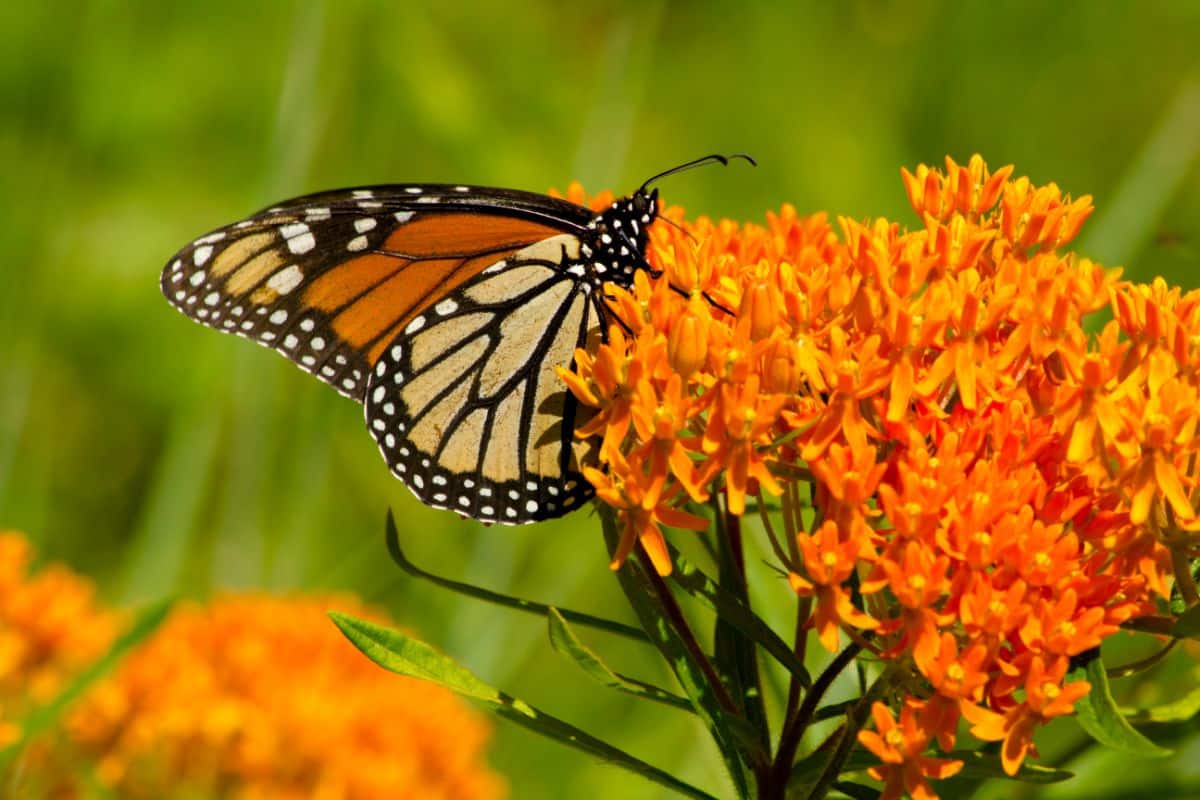
| Plant name: | Butterfly weed |
| Light requirements: | Full sun |
| Water requirements: | Low |
| Perennial or annual? | Perennial |
| Growing zone: | Zones 3 to 9 |
Butterfly weed is a variety of milkweed that’s native to North America. This colorful plant produces clusters of bright orange flowers from June to August, which are full of nectar and provide an important food source for butterflies. If you want to grow these plants, just be patient, as it can take 3 years for them to mature enough to bloom.
Butterfly weed can be directly sown in your garden, or you can choose to start it indoors with cold stratification methods. Once mature, plants will grow to about 2’ tall, and they will produce fuzzy seeds that are easily dispersed by the wind once the flowers fade. A hardy plant overall, butterfly weed is drought resistant and can grow in a wide variety of soils, including rocky substrates.
4. Sunflower (Helianthus spp.)
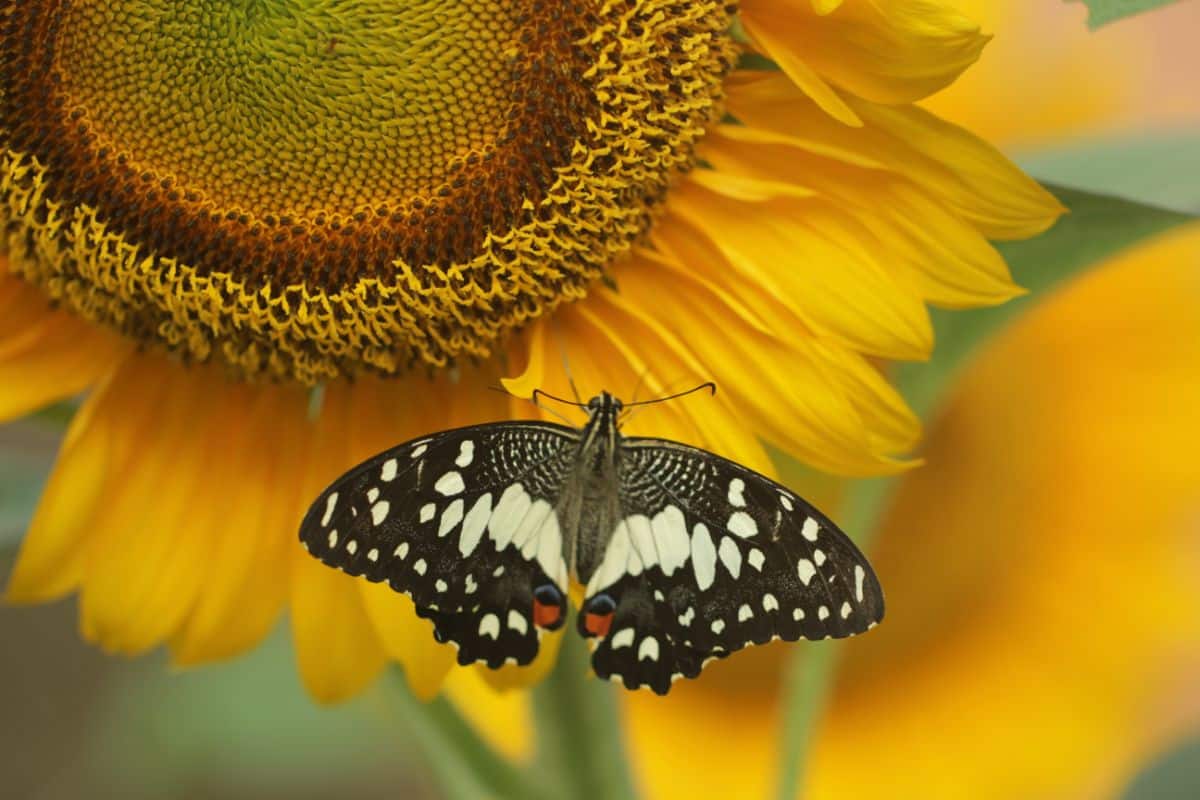
| Plant name: | Sunflower |
| Light requirements: | Full sun |
| Water requirements: | Moderate |
| Perennial or annual? | Annual |
| Growing zone: | Zones 4 to 9 |
Butterflies’ wide wingspans can make it difficult for them to feed from certain flower shapes, but sunflowers’ wide, flat flowerheads are perfect landing pads for even the largest butterflies. Sunflowers are rich in nectar and pollen, which butterflies, bees, and other beneficial insects need to thrive. After the flowers fade, they develop protein-rich seeds that birds love too!
Planting sunflowers in your garden will encourage butterflies and other pollinators to visit, which can increase pollination rates and boost your harvest yields for plants like squash and zucchini. Sunflowers can also be used as natural supports for climbing beans and cucumbers if you prefer an all-natural look to your landscape.
5. Tall phlox (Phlox paniculata)
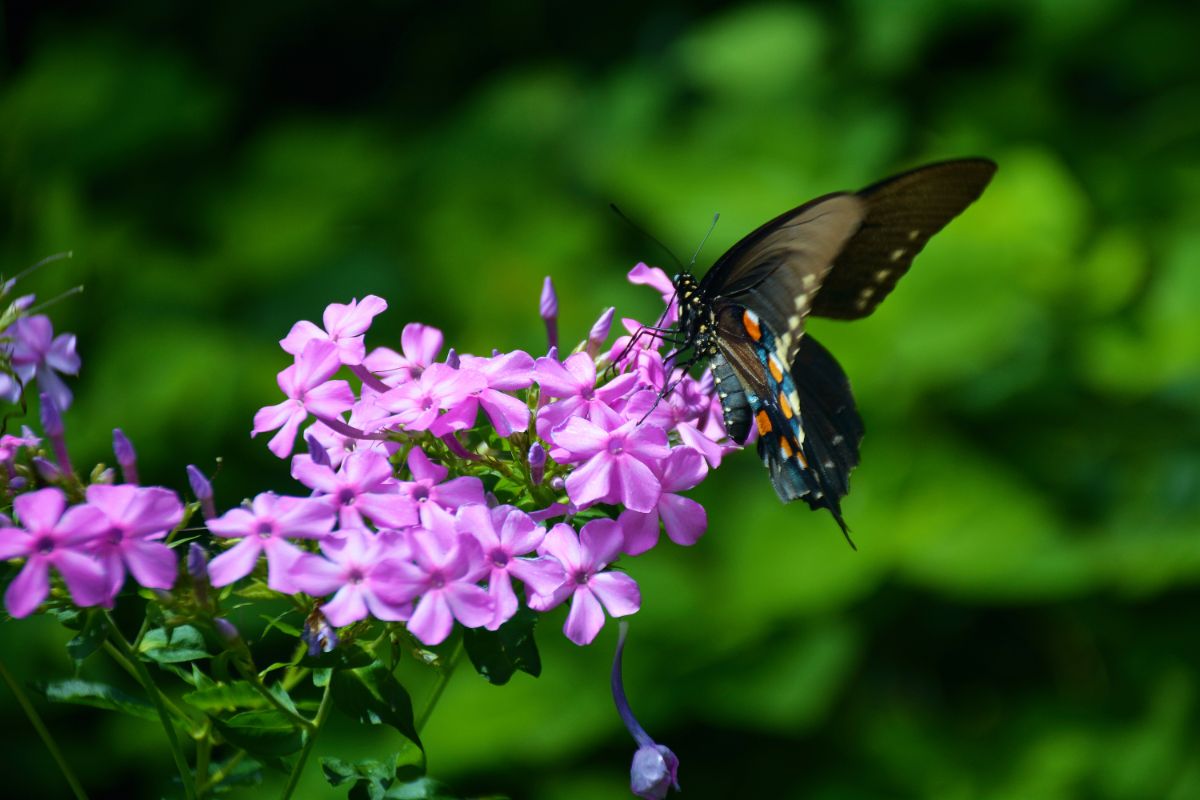
| Plant name: | Tall phlox |
| Light requirements: | Full sun to part shade |
| Water requirements: | Moderate |
| Perennial or annual? | Perennial |
| Growing zone: | Zones 4 to 8 |
Tall phlox blooms from mid to late summer, producing attractive clusters of fragrant flowers that butterflies can’t resist. Phlox blooms in white and various shades of pink, purple, and yellow, and many flowers feature two-toned blooms that are even more striking. Growing up to 3’ tall, this variety of phlox is well-suited for mid-garden planting and looks stunning when paired with liatris or shorter plants, like yarrow and zinnias.
Tall phlox can be prone to mildew issues, so it’s important to ensure your plants are adequately spaced. Only watering your plants in the morning and directing water to the base of your plants can also keep leaves dry and prevent fungal diseases.
6. Purple coneflower (Echinacea purpurea)
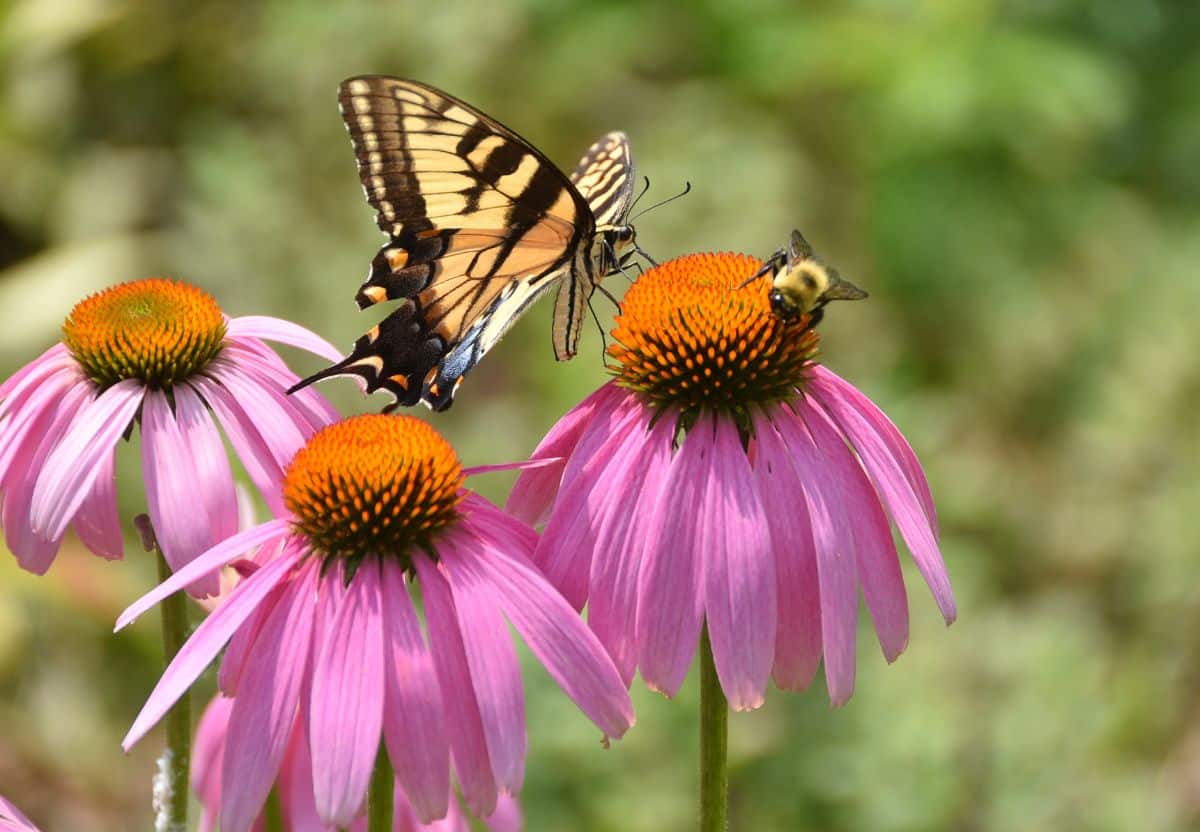
| Plant name: | Purple coneflower |
| Light requirements: | Full sun |
| Water requirements: | Moderate to low |
| Perennial or annual? | Perennial |
| Growing zone: | Zones 3 to 9 |
Purple coneflowers are low-maintenance plants that are quite a drought resistant and require minimal care. If you want to attract butterflies to your garden but don’t want a lot of fuss, try planting your garden bed with coneflower, black-eyed Susan, goldenrod, and yarrow. These plants all have similar care requirements and pair beautifully together too!
Purple coneflowers can be purchased as nursery starts, but they are easy enough to grow from seed as well. Like many other wildflowers, germination rates are improved significantly if you use cold stratification methods when planting. Also, if your garden has a lot of deer, purple coneflower can be the solution, as these plants are naturally deer-proof.
7. Lantana (Lantana camara)
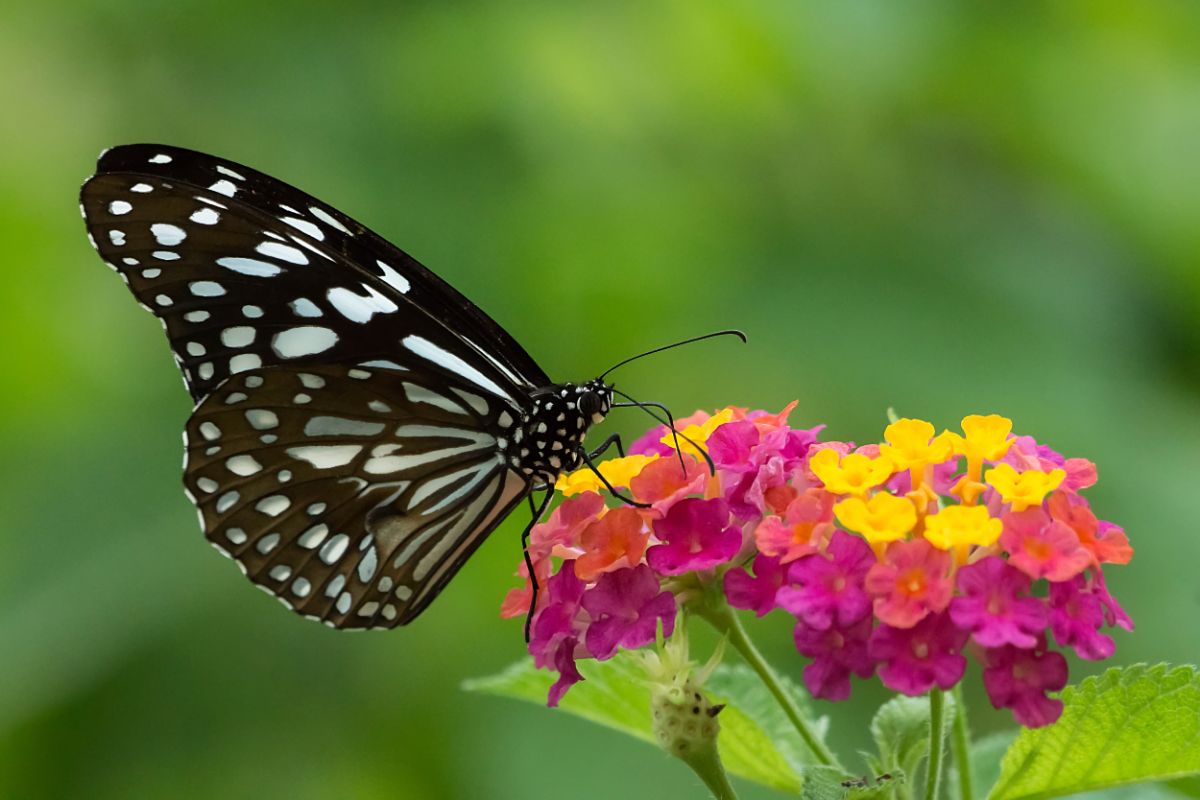
| Plant name: | Lantana |
| Light requirements: | Full sun |
| Water requirements: | Moderate |
| Perennial or annual? | Perennial, grown as an annual in cooler locations |
| Growing zone: | Zones 9 to 11 |
Lantana is a bold plant to grow with bright flowers in pinks, oranges, and many other colors. These plants emit a citrus-like fragrance, which can be quite strong, but it makes them very alluring to many species of butterflies. The spicebush swallowtail, in particular, is a frequent visitor of this plant.
Lantana has a sprawling growth habit that makes it a popular flower to grow in hanging baskets. Often, these plants are kept as annuals, but they can come back year after year if grown in warmer regions. For best results, provide your lantana with plenty of bright sun and water your plants regularly so that the soil never dries out completely.
8. Black-eyed Susan (Rudbeckia hirta)
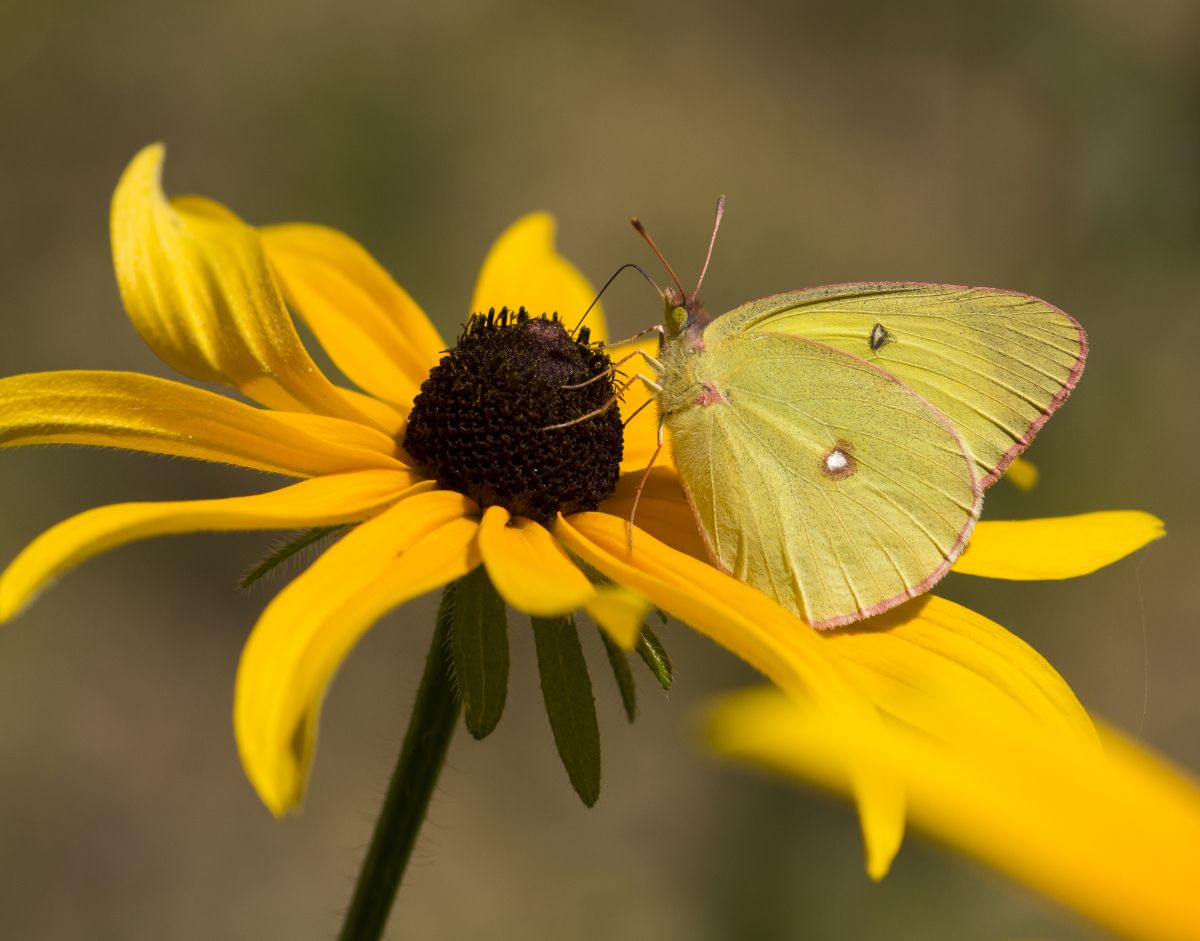
| Plant name: | Black-eyed Susan |
| Light requirements: | Full sun |
| Water requirements: | Moderate to low |
| Perennial or annual? | Perennial |
| Growing zone: | Zones 3 to 10 |
Black-eyed Susan is a happy-looking plant featuring a chocolate-brown center that is surrounded by richly hued petals in golden-orange, maroon, or bronze. Top pollinator plants for bees, these flowers also attract butterflies, which can easily feed from the plants’ wide open flower heads.
Like purple coneflower, black-eyed Susan is a hardy plant that doesn’t need a lot of water. After the first year, black-eyed Susan will usually produce a lot of seeds and will reseed themselves. Birds love black-eyed Susan seeds, too, and you can often spot them gobbling up the seeds in autumn!
9. Joe Pye weed (Eutrochium purpureum)

| Plant name: | Joe Pye weed |
| Light requirements: | Full sun to part shade |
| Water requirements: | High to moderate |
| Perennial or annual? | Perennial |
| Growing zone: | Zones 4 to 8 |
Joe Pye weeds are often overlooked plants in backyard gardens, but they have been gaining popularity in recent years. These North American natives are stately plants that can grow up to 7’ tall. Once mature, they produce clusters of purple flowers that are highly fragranced with notes of vanilla.
In nature, Joe Pye weed can often be found growing along highways and streambanks. In the garden, this plant prefers consistently moist, but not soggy, soil. To reduce watering needs, try adding a thick layer of mulch beneath these plants to help conserve moisture in your garden.
10. Hollyhock (Alcea rosea)
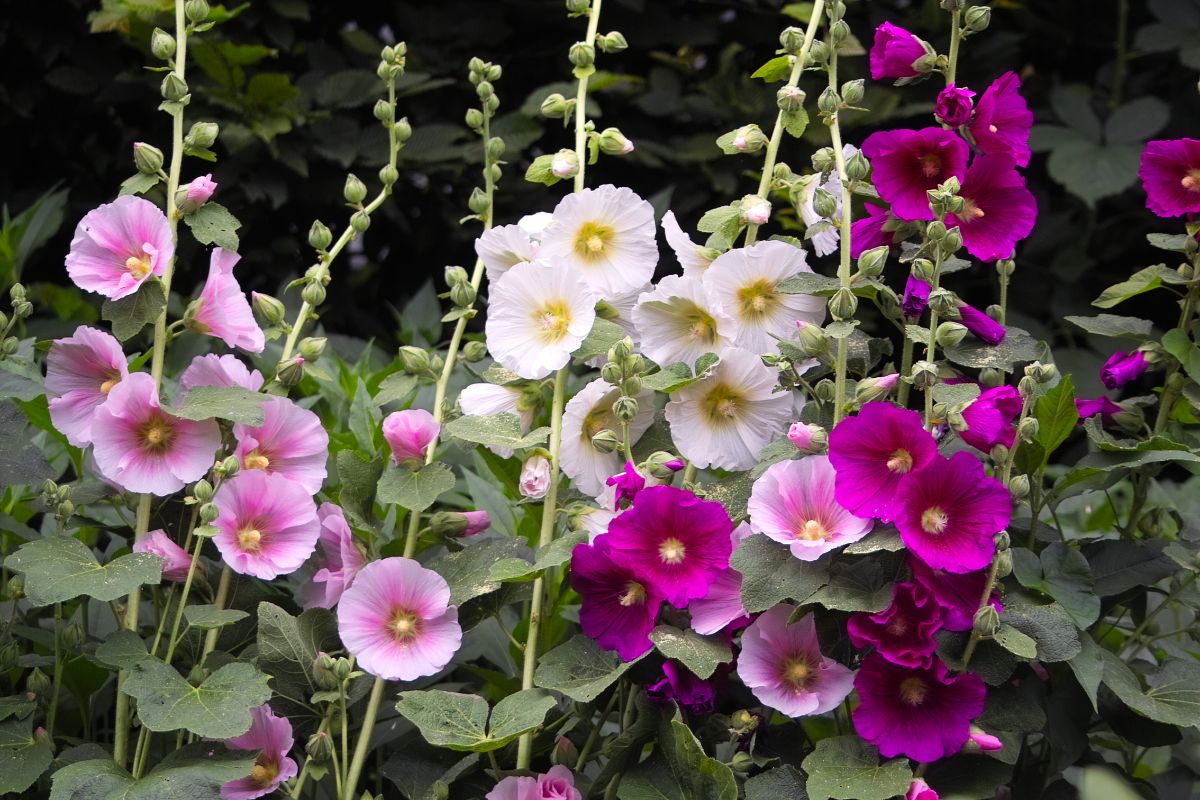
| Plant name: | Hollyhock |
| Light requirements: | Full sun to part shade |
| Water requirements: | Low |
| Perennial or annual? | Perennial |
| Growing zone: | Zones 3 to 8 |
Hollyhocks are the perfect addition to cottage gardens, offering both charm and a touch of whimsy with their large, saucer-shaped blooms. Plants can grow up to 8’ tall and look particularly stunning as backdrop plants or when planted along a garden fence or trellis. Flowers come in almost every color you could want, including yellow, pink, and purple.
As a variety of mallow, hollyhocks need a good deal of water when they’re just getting established, but older plants are relatively drought-tolerant. When watering, be sure to direct water to the base of your plants so that leaves remain dry and mildew-free. While hollyhocks can have both double or single blooms, opt for single bloom varieties in pollinator gardens, as these plants are easier for butterflies to feed from.
11. Verbena (Verbena spp.)
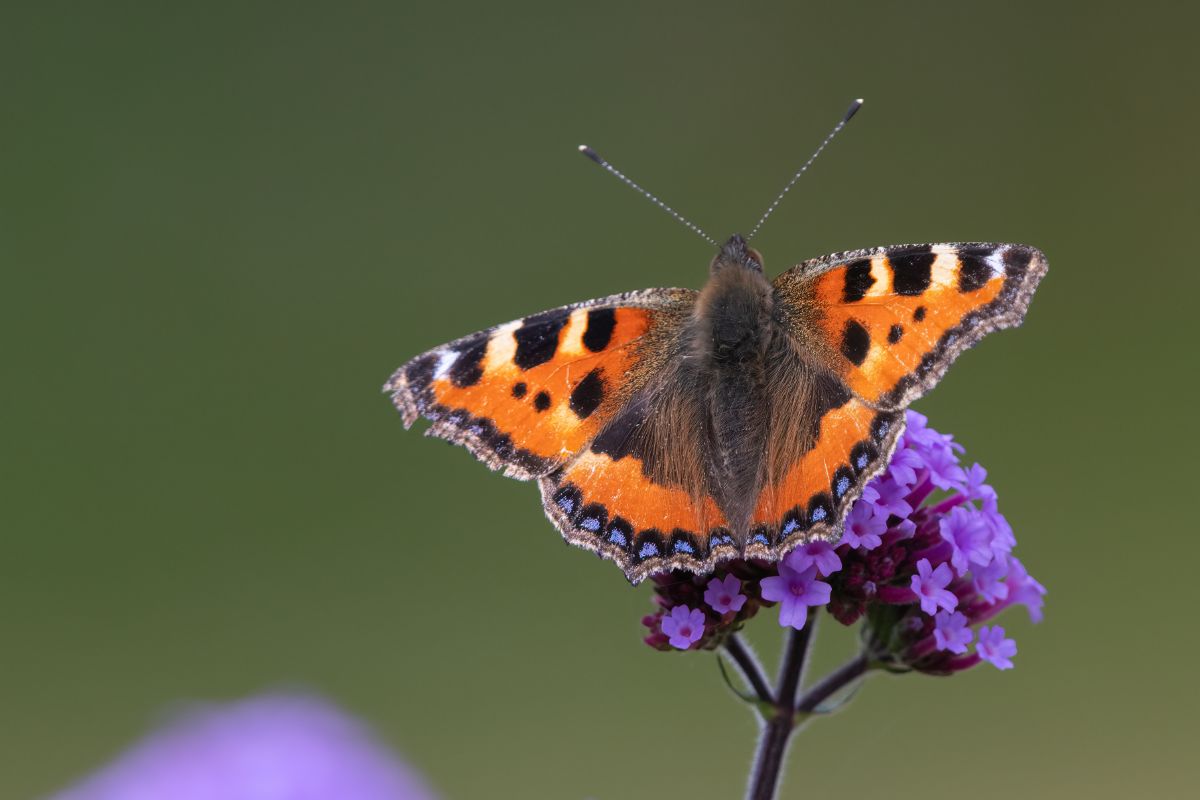
| Plant name: | Verbena |
| Light requirements: | Full sun |
| Water requirements: | Moderate |
| Perennial or annual? | Both |
| Growing zone: | Zones 8 to 11 |
Also known as vervain, there are over 250 different species of verbena, so there are lots of different varieties to choose from if you want to grow these plants. Both annual and perennial types are available, and some verbena cultivars boast a more upright growth habit, while others sprawl and trail beautifully out of containers and shorter garden beds.
Verbena flowers are tall and airy clusters that can bloom from spring through fall, depending on the cultivar. If you want to extend bloom time, try pruning your verbena back some during the growing season. This will help rejuvenate your plants and encourage them to produce more blooms.
12. Goldenrod (Solidago spp.)
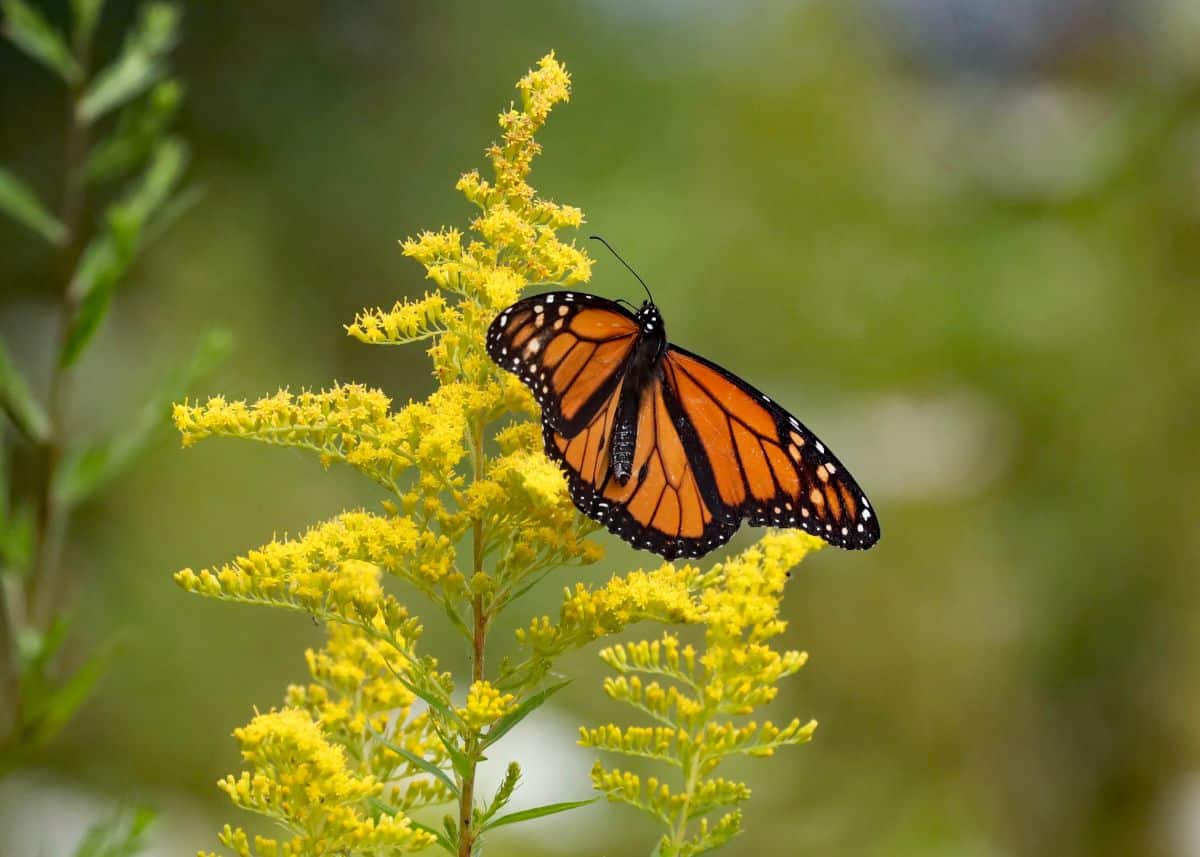
| Plant name: | Goldenrod |
| Light requirements: | Full sun |
| Water requirements: | Low |
| Perennial or annual? | Perennial |
| Growing zone: | Zones 2 to 8 |
Many gardeners stay away from goldenrod because they associate these plants with allergies. However, goldenrod plants are not often the cause of seasonal allergies. In fact, it’s actually ragweed, a similar-looking plant, that’s to blame.
In the garden, goldenrod produces vibrant clusters of golden yellow flowers that form in gently arching points. One of the last flowers to bloom in autumn, the goldenrod provides an important source of nectar for late-season butterflies. These plants are also hardy and drought-resistant, making them a good pick if you’re new to gardening.
13. Dill (Anethum graveolens)
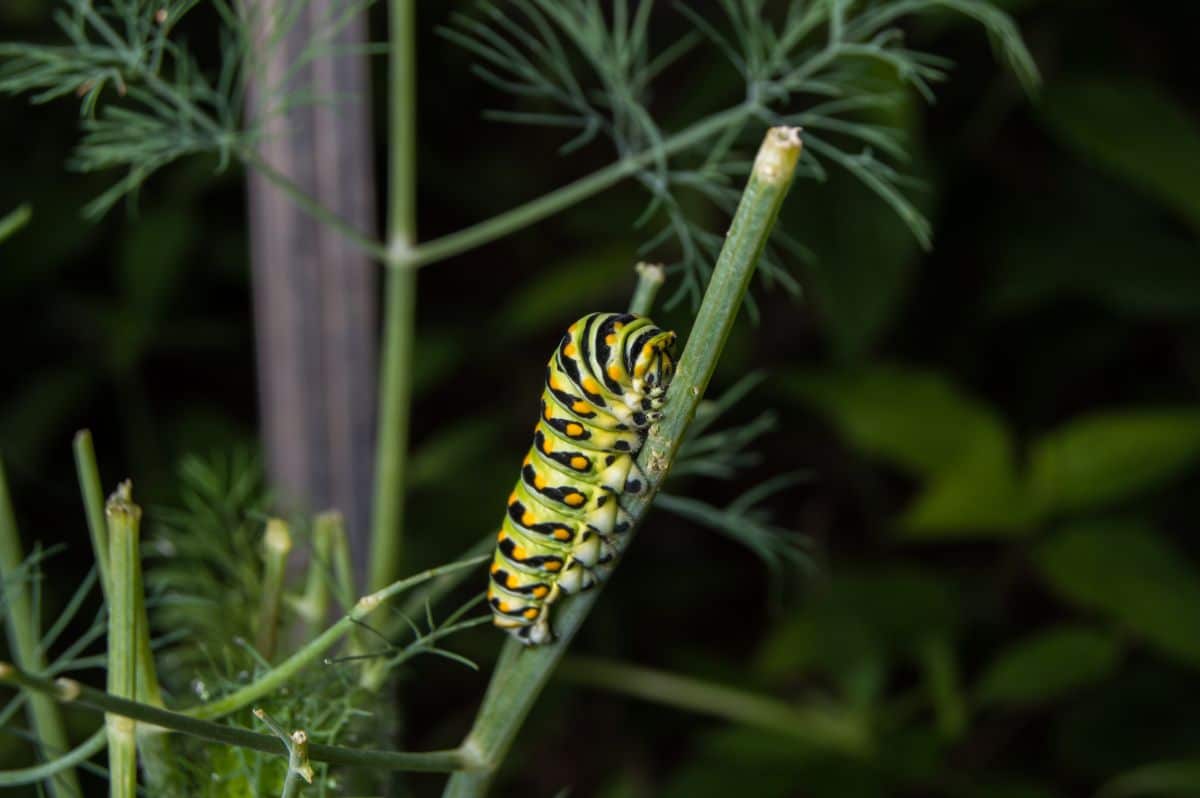
| Plant name: | Dill |
| Light requirements: | Full sun to part shade |
| Water requirements: | Moderate |
| Perennial or annual? | Annual |
| Growing zone: | Zones 2 to 11 |
Dill isn’t often thought of as a flowering plant, but it is an important plant to grow if you want to attract butterflies. Dill is one of the best host plants for certain butterfly species, including black and anise swallowtails. Adult swallowtails lay their eggs on dill plants to provide a quality source of food for their caterpillars once they hatch.
Because so many butterflies love to eat dill, many gardeners choose to plant extra dill seeds just for pollinators to munch on. As a cold-season crop, dill bolts in summer and becomes less tasty for humans. But you can still leave your dill plants in your garden after they bolt to feed visiting butterflies.
14. Sedum (Sedum spp.)
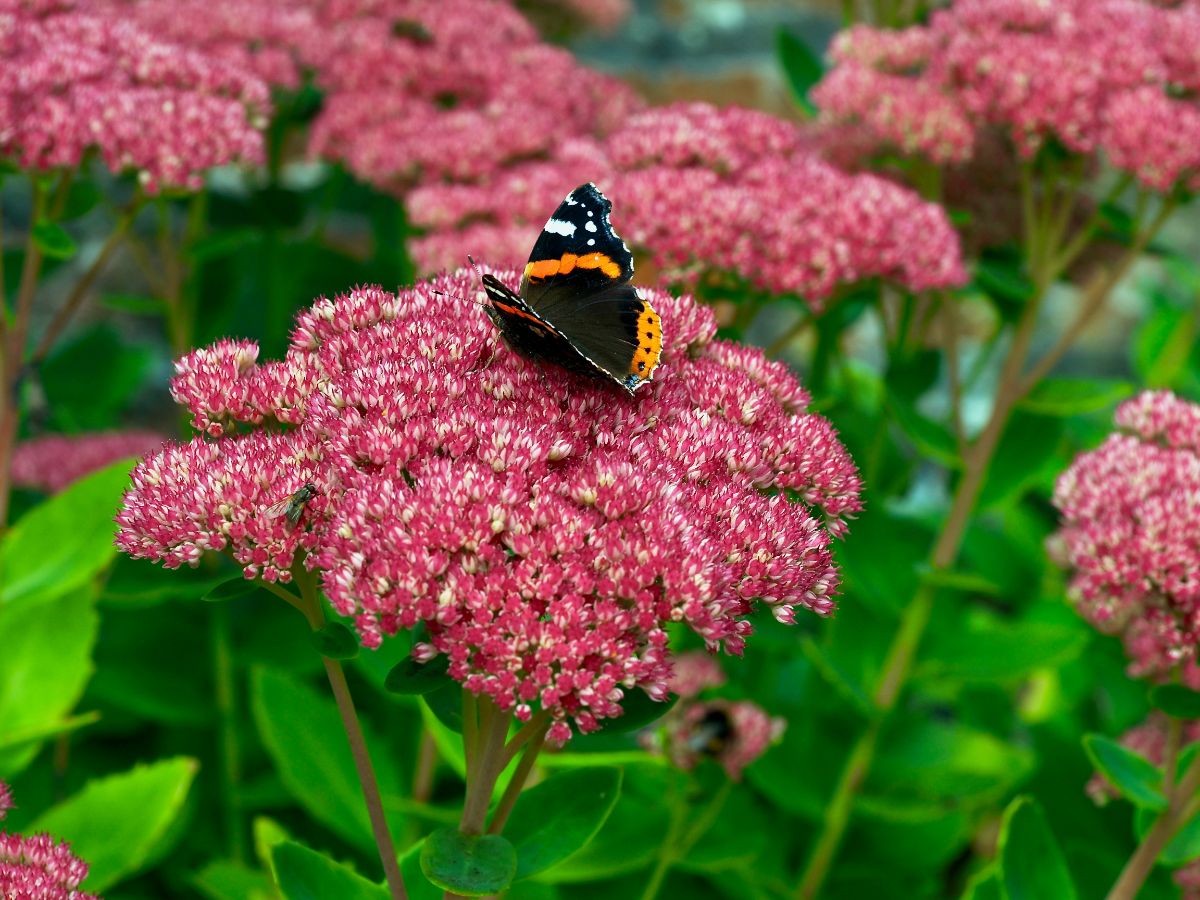
| Plant name: | Sedum |
| Light requirements: | Full sun |
| Water requirements: | Low |
| Perennial or annual? | Perennial |
| Growing zone: | Zones 3 to 11 |
Sedum is some of the last plants to bloom in autumn, making them very important for late-season butterflies. The wide, flat blooms of sedum flowers are easy for butterflies to land on, and the flowers are rich in nectar that butterflies need to survive.
Also known as stonecrops, sedum is a variety of succulents, and they don’t need much water. That makes them great plants to keep if you live in an area that is prone to drought. As autumn progresses, sedum flowers dry beautifully on the plant and can remain there throughout the winter for extra interest in your garden beds.
15. Salvia (Salvia spp.)
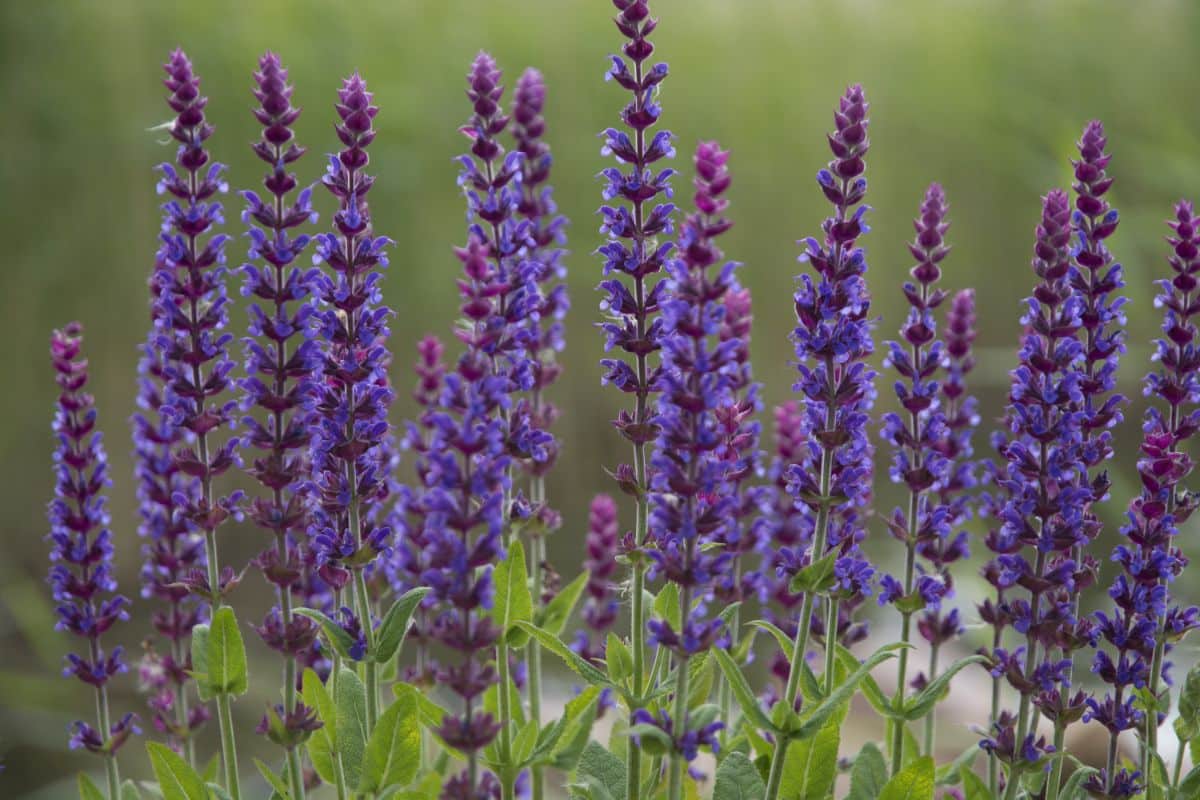
| Plant name: | Salvia |
| Light requirements: | Full sun to part shade |
| Water requirements: | Moderate to low |
| Perennial or annual? | Both |
| Growing zone: | Zones 5 to 9 |
There are hundreds of different species of salvia, including both annual and perennial varieties, so there are a lot of choices available if you’d like to grow these plants. Salvias are top pollinator plants that are attractive to butterflies, as well as many other pollinator species. Plus, they are low maintenance and great for beginning gardeners too.
Salvia flowers generally appear as tall and slender spires with petals ranging in color from red to purple and lots of other hues too! These plants grow best in full sun and well-drained soil. As a variety of mint, salvias can spread, and they can be easily divided to create more plants to sow throughout your gardening space.
16. Liatris (Liatris spicata)
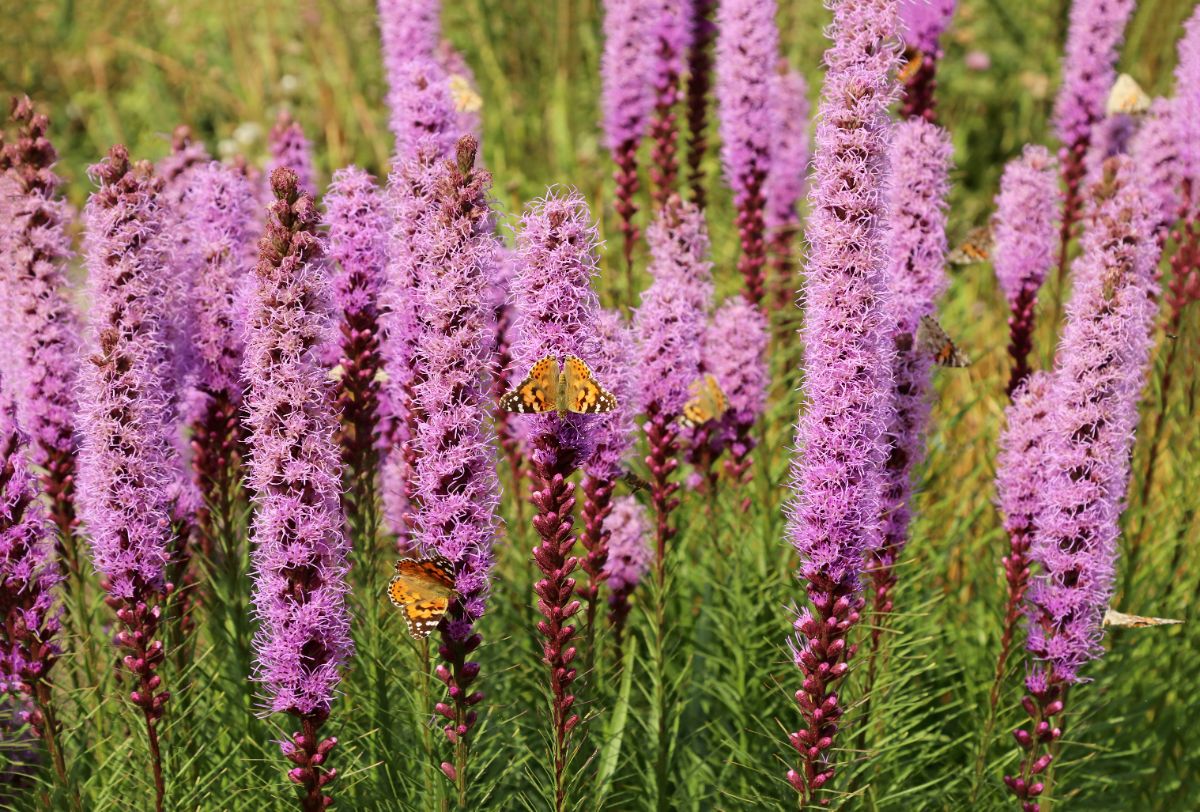
| Plant name: | Liatris |
| Light requirements: | Full sun |
| Water requirements: | Low |
| Perennial or annual? | Perennial |
| Growing zone: | Zones 3 to 8 |
Also known as blazing stars, Liatris are attractive and highly structural plants that produce tall, columnar flowers that are quite striking. Liatris blooms commonly come in pink to purple, although you can find white varieties as well. These plants produce grass-like leaves and create a fun silhouette that pairs beautifully with globular alliums or more traditional coneflowers.
Liatris can be purchased as both nursery starts or corms, which are generally planted in garden beds in spring. Attractive to many different types of butterflies, you may spot painted ladies, swallowtails, monarchs, and spangled fritillaries supping on the nectar of these gorgeous plants.
17. Anise hyssop (Agastache foeniculum)
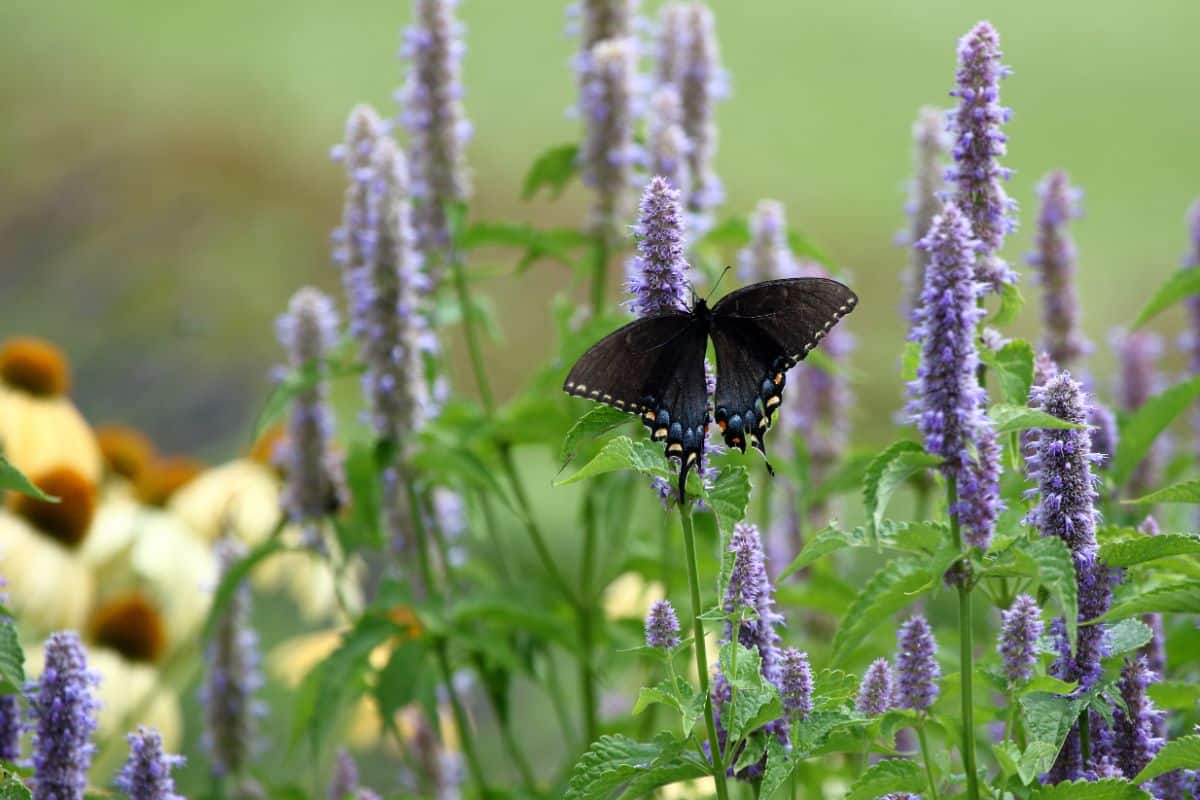
| Plant name: | Anise hyssop |
| Light requirements: | Full sun |
| Water requirements: | Low |
| Perennial or annual? | Perennial |
| Growing zone: | Zones 4 to 8 |
Anise hyssop is sometimes cultivated as an herb for herbal teas and seasoning blends, and it offers a distinct anise or licorice-like flavor. But this plant is also irresistible to butterflies, which will flock to the tall, spiky flowers in droves.
Anise hyssop flowers come in purples and blues, and the plants themselves grow between 2 and 4’ high. That makes anise hyssop a good choice for mid-garden planting, but their ability to spread means they are ideal for ornamental borders as well. These highly adaptable plants can also tolerate full sun to part shade, making them well-suited to most garden designs.
18. Lavender (Lavandula spp.)
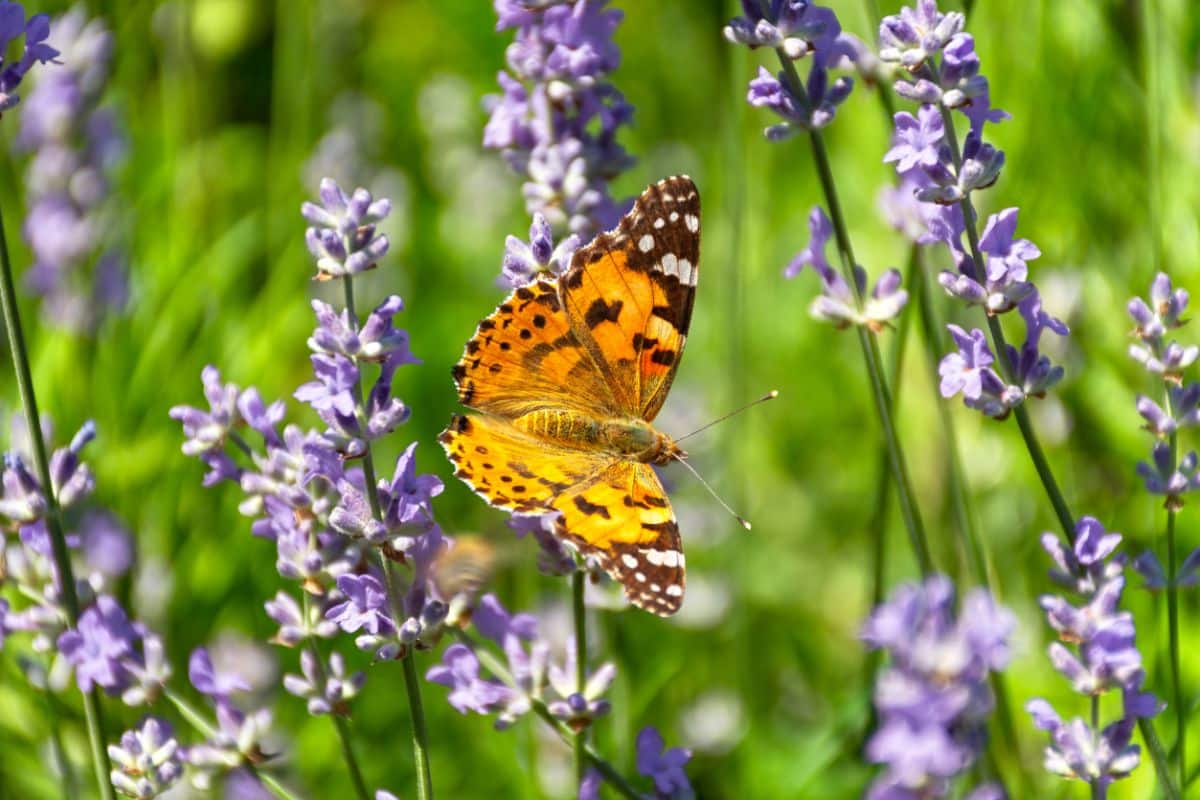
| Plant name: | Lavender |
| Light requirements: | Full sun |
| Water requirements: | Low |
| Perennial or annual? | Perennial |
| Growing zone: | Zones 5 to 10, depending on variety |
Lavender isn’t just a pleasing herb to grow for potpourri making and desserts. Lavender’s fragrant blooms also make it one of the best herbs to keep if you want to draw butterflies and other pollinators to your landscape.
Lavender is native to the Mediterranean, where it naturally grows in low-moisture areas with well-draining soil. In the garden, lavender needs minimal watering and lots of bright sun. This plant’s compact size also makes it well-suited for container growing, although it works well in inground beds too.
19. Zinnia (Zinnia elegans)

| Plant name: | Zinnia |
| Light requirements: | Full sun to part shade |
| Water requirements: | High |
| Perennial or annual? | Annual |
| Growing zone: | Zones 3 to 10 |
Zinnias come in almost every color you could want, so if you love vibrant landscapes, they are one of the best plants to try. Zinnias are easy to grow from seed, but you can also find them as nursery starts at garden centers too. These plants grow as annuals, but they also readily self-seed, so you can keep your plants growing year after year if you want to.
Zinnias are available in lots of different sizes, from dwarf varieties to taller specimens that can stretch up to 4’ high. Zinnias also come in both double and single-bloom types, but single-bloom cultivars are recommended for pollinator gardens as they are much easier for butterflies to feed from.
20. Yarrow (Achillea millefolium)
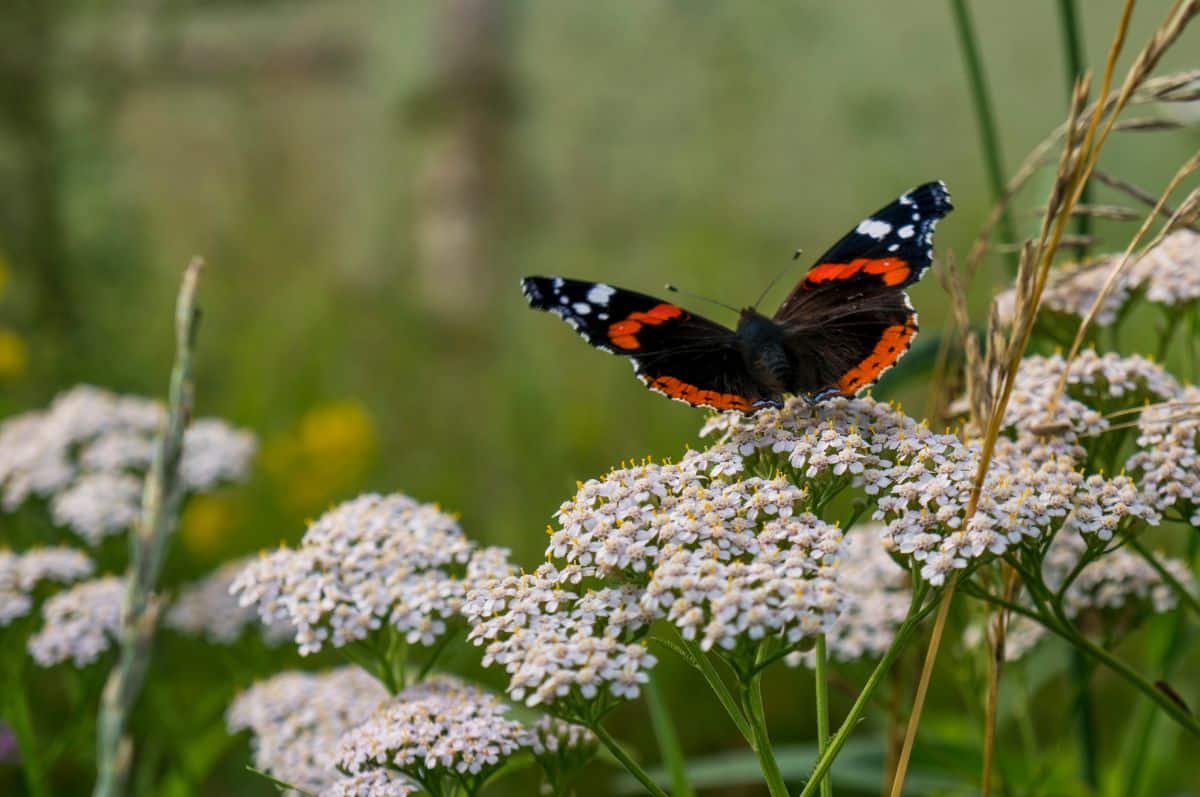
| Plant name: | Yarrow |
| Light requirements: | Full sun |
| Water requirements: | Low |
| Perennial or annual? | Perennial |
| Growing zone: | Zones 3 to 9 |
Yarrow is a low-maintenance plant that is a member of the Aster family. Attractive, broad, and flat blooms are just the right shape and size for butterflies to perch on. Flowers come in pinks, yellows, and white, and they appear on long stems above the plant’s delicate and feathery foliage.
Yarrow is a good choice if you want to attract butterflies, but you don’t have a lot of time to spend gardening. These plants are drought-tolerant and naturally deer resistant, and they need minimal to no fertilizer. Just provide them with plenty of bright sun and yarrow will reward you with gorgeous blooms year after year!
Summary
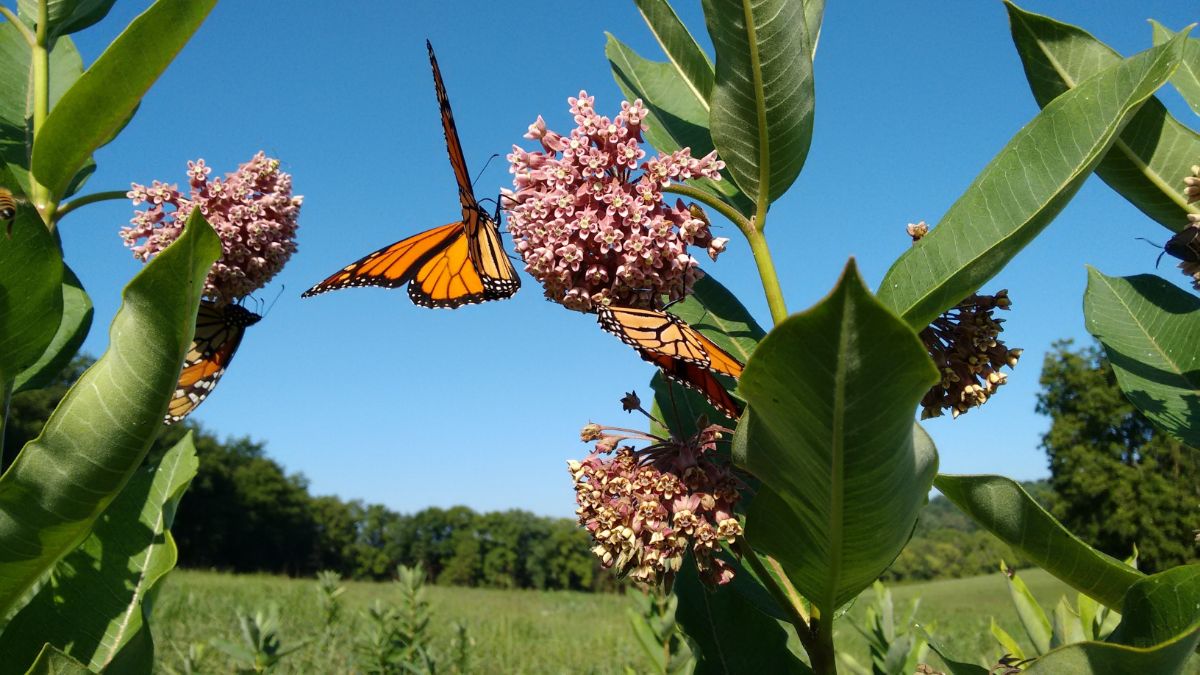
Whether you have a large garden or just a few container plants, you can attract a lot of butterflies to your outdoor space with just a few well-chosen flowers. To ensure your garden is as alluring to butterflies as possible, try to include a variety of plants and consider the entire growing season. If you can, select varieties that will bloom in spring, summer, and fall so that whenever butterflies visit, they’ll always have something tasty to eat.
If you enjoyed this article and want to learn more about gardening for pollinators, check out our full guide here.

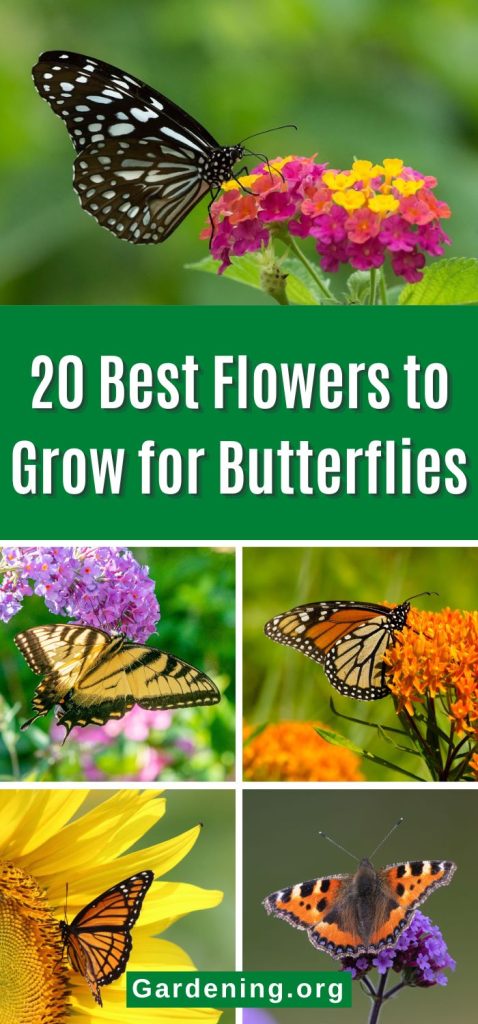
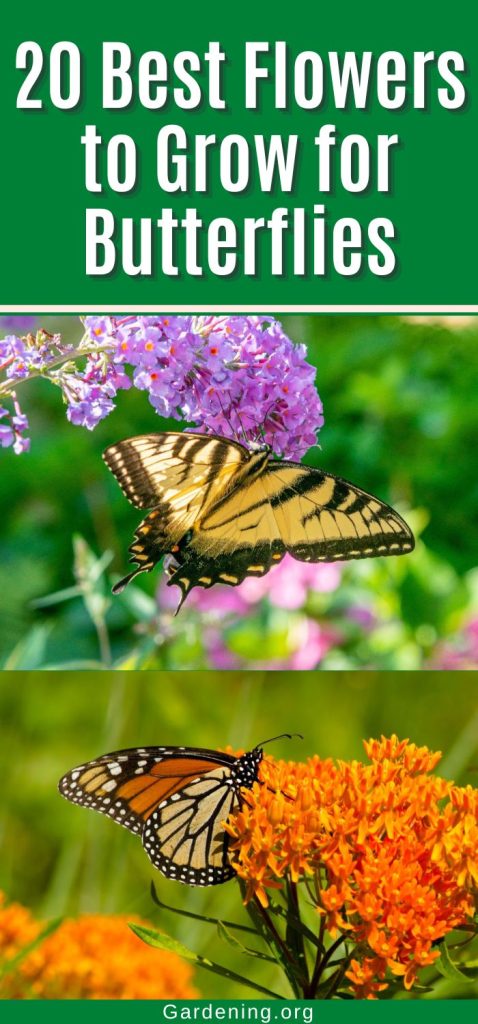
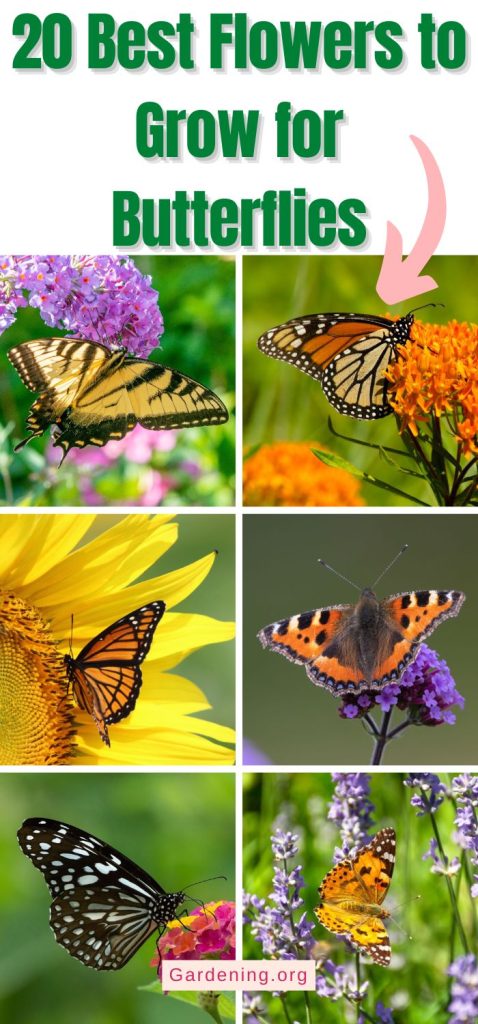
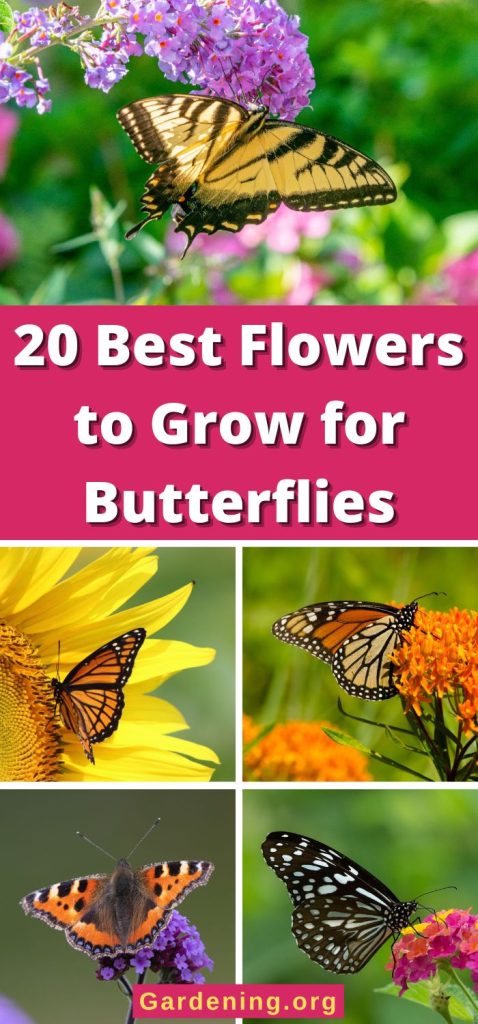

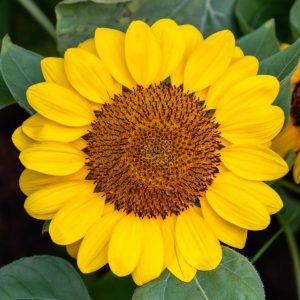
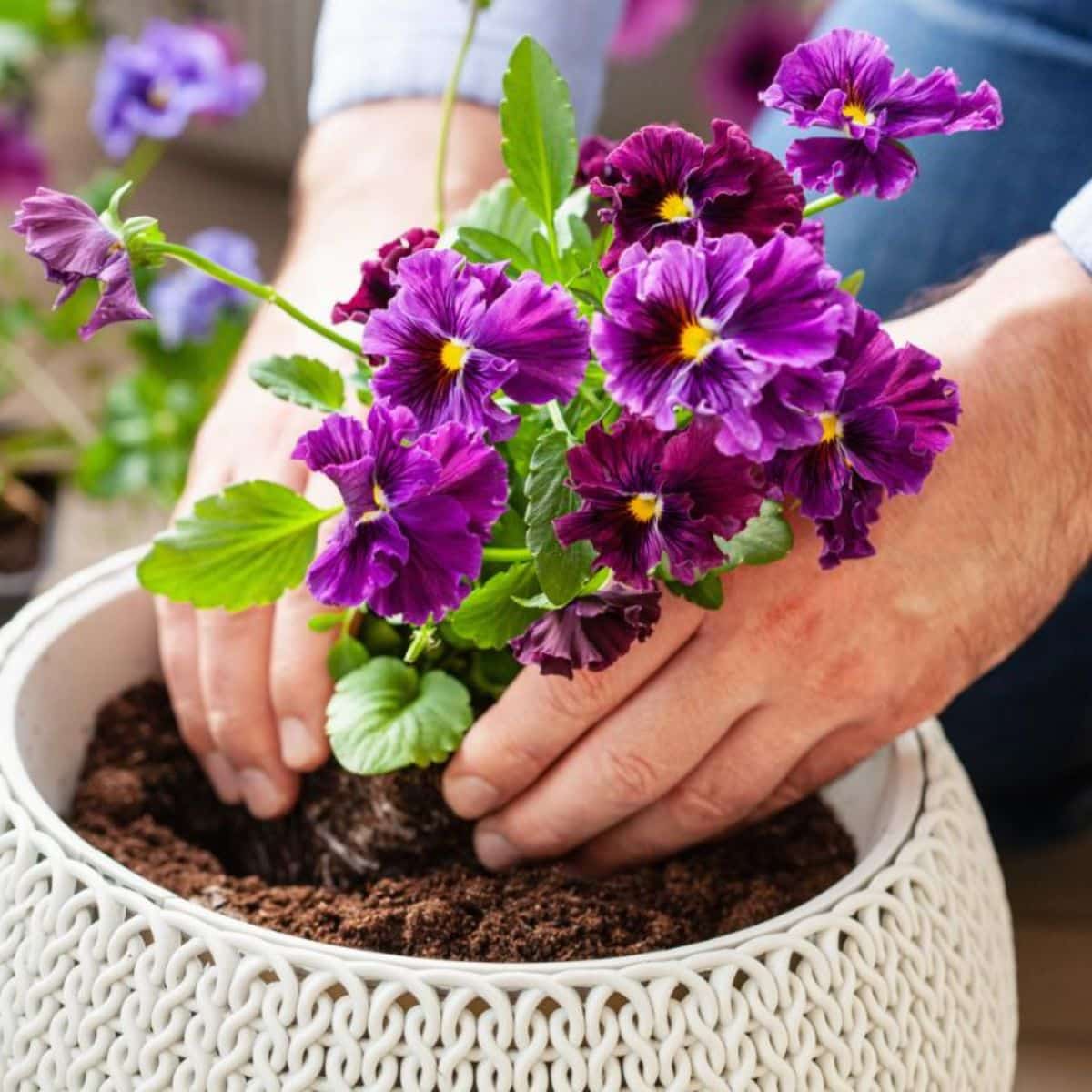
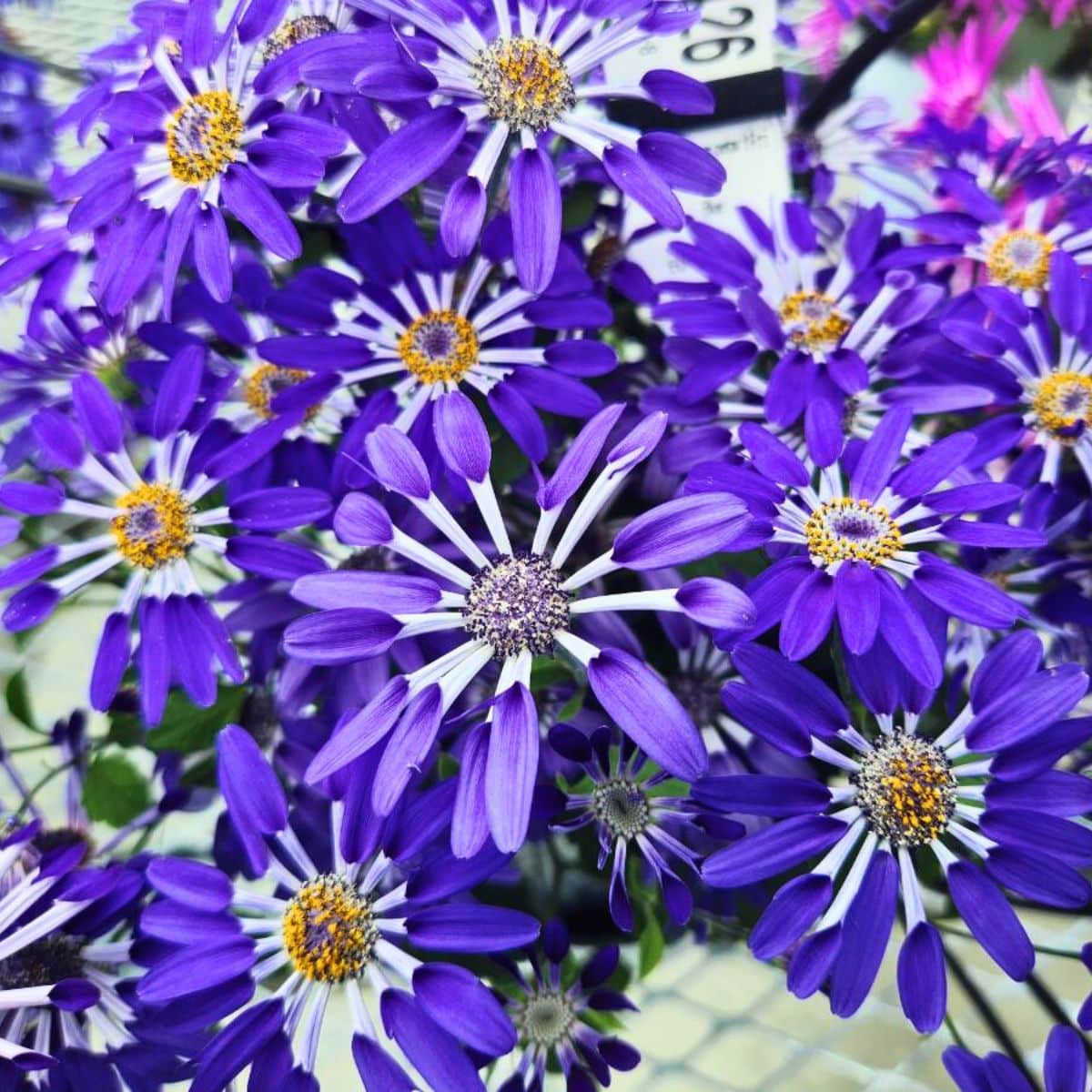
Leave a Reply